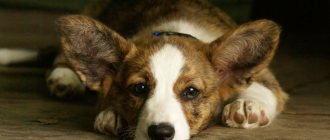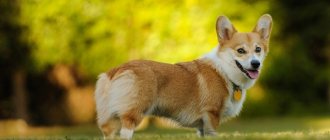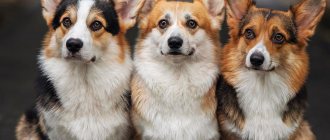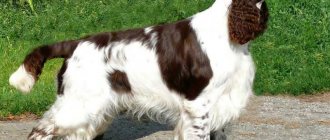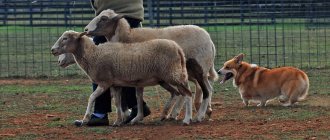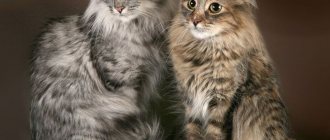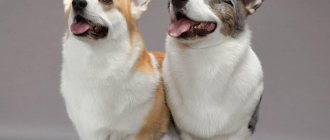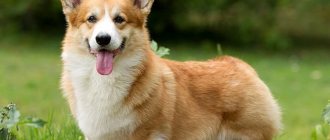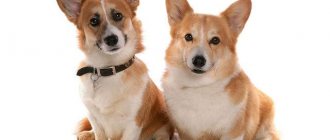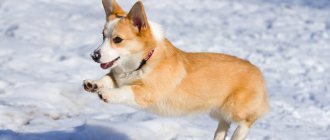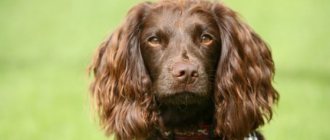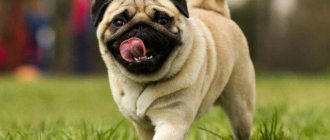History of the Pembroke Welsh Corgi breed
The history of the Pembroke Welsh Corgi breed goes back centuries. While excavating at the site of a settlement that existed at the turn of the 8th-9th centuries in South Wales, scientists from Cardiff University, among other finds, discovered the bones of a small dog, very similar to parts of the skeleton of modern corgis.
Pembroke Welsh Corgi
Written references to the breed are first found in the code of laws of the Welsh king Hywel the Good, who ruled in these parts in the 10th century. According to the provisions of the law, for the murder of a corgi herding cattle, its owner had the right to demand a whole ox from the culprit as compensation for damages. It is interesting that for dogs of any other breed, even if they were the property of the king, no one gave more than a ram. The fact is that Welsh Corgis herded herds without human intervention, independently accompanied the herd, fearlessly defended it from wolves and robbers, that is, they worked both for themselves and for the owner. The death of such an assistant was indeed a very tangible loss.
According to one version, the ancestors of today's Pembrokes were brought to the islands of Foggy Albion by the Vikings. Perhaps these were Lundehunds, the similarity with which lies not only in size, but also in the special arrangement of the ears, which prevents sand and moisture from getting deep into the auricle. The corgi has a lot in common with another representative of the Spitz - the Swedish Vallhund.
The main function of these pets in those days was shepherding, and we are not just talking about flocks of sheep. Corgis also looked after herds of ponies superbly, and when a boom in poultry breeding (mainly geese and ducks) began in Wales, it was simply impossible to find a better assistant in accompanying these very capricious birds to city markets. Several dogs, working as a well-organized team, transported huge flocks of birds to their destination with almost no losses. It was also important that the representatives of the breed did their job without barking and did not irritate the bird.
Elizabeth II with her corgis
The Pembroke Welsh Corgi traces its origins to the Welsh county of Pembrokeshire. This area is separated by the Cumbrian Mountains from Cardiganshire, where the Cardigan Welsh Corgi originates. Despite the similarity of names, these are still different dogs. Due to their isolated existence in certain mountainous areas and, as a consequence, inbreeding, each breed has acquired characteristics unique to this type of dog.
As for the meaning of the words “Welsh Pembroke” or “Welsh Cardigan” in the name of the breed, everything is more or less clear. But the word “corgi” can be translated in different ways. Some believe that the word comes from the Welsh "cor" (observe, collect) plus "gi" (dog). Others interpret "corgi" to mean "mixed dog" or "evil dog." Still others translate “cor” as “gnome, dwarf.”
The official debut of the breed at exhibitions took place in England and dates back to 1925. Both species - the Pembroke and the Cardigan - were considered to be representatives of the same breed until 1934, when the Kennel Club of Great Britain recognized them as completely independent of each other. In the same 1934, for greater differentiation of types, it was decided to dock the Pembroke’s tails.
Pembroke Welsh Corgis have gained extreme popularity due to the fact that they are favorites of the British royal family. Back in 1933, the Duke of York, later King George VI, gave his daughters a small Pembroke. Since then, these wonderful dogs have become permanent residents of Buckingham Palace and even participate in official receptions, and Her Majesty Queen Elizabeth II is rightfully considered the world's greatest fan and connoisseur of the breed.
Corgi puppy chasing butterflies
Origin story
The history of the Welsh Corgi breed dates back to the 9th century, according to archaeological excavations in South Wales, the first mention in chronicles dates back to the 10th century.
The British dog breed has two varieties: Cardiganshire and Pembrokeshire . Two species originated in different areas of Wales, hence their names: the Cardigan Welsh Corgi and the Pembroke Welsh Corgi.
The most popular type is Pembroke . The variety became widespread thanks to the royal family; Queen Elizabeth II is considered an expert and lover of the breed.
Thanks to its funny and playful character and smiling face, the corgi quickly won the hearts of not only Welsh peasants, but also representatives of royal families.
Peasants used the dog as a shepherd; it successfully coped with the responsibilities of monitoring and protecting the herd.
Despite its centuries-old history, the breed began to be shown at exhibitions and competitions only in 1925; corgis owe this to the love of the royal daughters for themselves and the attention of the secular public.
Appearance of a Welsh Corgi
Welsh Corgi Pembroke
The Pembroke Welsh Corgi is a squat, compact and strong dog. The length of the body (from the withers to the base of the tail) is approximately 40% greater than the height from the withers to the ground (25-30 cm).
The weight of the animal is proportional to its height and is up to 12.7 kg for females and no more than 13.6 kg for males.
Exhibition representatives of the breed should have less weight - about 11.4 kg and 12.4 kg, respectively.
Head and skull
The corgi's head is shaped like a fox's, the skull is quite wide and flat between the ears. The muzzle is proportional to the skull in a ratio of 3:5, tapering slightly towards the nose. The transition from forehead to muzzle is moderately pronounced. The nose is always black.
Jaws and teeth
The Corgi's jaws are strong with a well-defined, regular scissor bite.
Eyes
Small size, round. The color of the iris is brown, which harmonizes well with the color of the coat.
Ears
Muzzle of a Pembroke Welsh Corgi
Medium size, sharp, with slightly rounded tips. A conditional line drawn from the nose through the center of the eye should cross the tip of the ear or pass very close to it.
Frame
Average. The chest is round, slightly ovoid and of moderate length. The topline is level, with a possible slight depression at the withers.
Tail
Short. Options are available: docked or natural. If the Corgi's tail is not docked, then it should be positioned in line with the top, carried fairly low and in no case thrown over the back.
Limbs
Corgi hind legs
The pasterns of the Pembroke Welsh Corgi's forelimbs are short and as straight as possible. The bones are wide right up to the paw, without narrowing. Elbows are close to the sides. The shoulders are harmoniously positioned and are at right angles to the forearms. The hind limbs are short and strong. The angles of the knee joints are good, the metatarsus are straight. The bones are strong.
The paws are oval in shape with strong toes, the two central ones are slightly pushed forward. The pads are dense and well filled. The claws are short.
Wool
Straight with a good dense undercoat. Never soft and wavy, nor wiry.
There can never be too many corgis
Black corgi puppy
Color
The color of the Welsh Corgi is red, light red, black and tan with possible light markings on the chest, neck and paws (tri-color), sable. The breed standard allows white markings on the head and muzzle.
The disadvantages of the Welsh Corgi breed include:
- incorrect tail position;
- an overly deep chest that interferes with the animal’s movements, a barrel-shaped or flat chest shape;
- high position of the dog’s hindquarters or, conversely, excessive sloping topline;
- straight hocks, narrowly set limbs;
- aggression or fearfulness in character;
- any deviations from a free natural gait (mincing step, “prancing”, “waddling” step).
In male dogs, two normally developed testicles should be clearly visible, fully descended into the scrotum.
Breed standard and what purebred dogs look like in the photo
Dogs of this breed are often compared to foxes due to the elongated and pointed structure of the muzzle, and the jaws are designed in such a way that it seems as if the dog is constantly smiling.
Welsh Corgis have a stocky build with a somewhat elongated body and short legs, but this does not prevent them from being energetic and quite fast.
Here are the general characteristics of the breed:
- The dog's weight is small, from 11.5 to 13 kg;
- height varies from 25 to 30 cm at the withers;
- There are several types of color, the most common colors are fawn and red with white spots, and there are also sable, tricolor, black and tan;
- the average life expectancy of the breed is up to 13 years;
- the character is sociable and friendly, dogs of this breed are loyal pets to the owner, and at the same time they treat all family members with love, without constant attention and communication they begin to feel sad;
- Welsh Corgis are considered dogs with high intelligence and great potential in training and learning.
Corgis are only suitable for living in a house or apartment..
An aviary is not the best place for them. Life on the street has a depressing effect on a dog of this breed, increasing feelings of loneliness and melancholy.
Purebred representatives of the Welsh Corgi breed have the following external features:
- elongated muzzle, long skull;
- eyes are round, slightly protruding;
- ears are small and pointed;
- medium length neck and voluminous chest;
- the tail is short, docked, but recently there have been representatives with tails of different lengths;
- The coat is short, thick and harsh.
Among the representatives of the breed there are also long-haired individuals; such dogs are called “fluffy”.
Photo of an adult Welsh Corgi
Personality of the Pembroke Welsh Corgi
All owners of Pembroke Welsh Corgi dogs speak almost unanimously about the wonderful character of these little shepherds. Among the main features are the animal’s activity, its high intelligence and amazing friendliness towards representatives of the human race. If corgis can still allow themselves to show some wariness and aggressiveness towards other dogs, then they almost never growl or bark at a person.
I have a corgi and I'm very happy about it ^-^
Initially, Pembrokes were exclusively herding dogs. This is an activity that requires endurance, intelligence and the ability to work in a team. Many people are sincerely surprised by the very high activity of the corgi, who loves to run, frolic and even have fun fooling around, despite his seemingly not entirely conducive appearance to such a pastime. Neither his modest size nor his short legs hinder him in this activity.
Pembroke Welsh Corgis are dogs that know how to sincerely enjoy life. It seems that these cute dogs simply do not know what the blues and bad mood are. Communication with the owner, walks and even work - everything gives the dogs pleasure. Their smiling face, full of enthusiasm and optimism, cannot leave anyone indifferent.
We still need to look for such a social creature as the Pembroke. They not only love their owner and strive to be near him. They want to be with their person always. Whatever you do, your favorite will be nearby. Dogs of this wonderful breed have one interesting feature - they love to touch their owner with their paws or nudge him with their nose. The Welsh Corgi sits down next to you and gently touches you several times in a row at short intervals, as if hinting that you simply cannot find a more interesting activity than chatting with such a highly attractive and intelligent dog. However, if you do not respond to these signs of attention, the animal will understand (not immediately) that it will have to wait. Fearing to miss the moment when the owner is free, the Pembroke will languish from loneliness and oblivion, lying down at your feet.
I think I've found the best place in this house!
Corgis love children very much. They stoically endure all manifestations of children's delight and intense games. No matter how actively they are pushed, kissed, squeezed, the animal will never show even the slightest hint of aggression towards the child.
Welsh Corgis consider themselves obligated to be aware of all events happening around them. This dog will even try to choose a place to sleep in the middle of the room or right on the passage, so that if something happens, he will be right there.
Shepherd work has developed another characteristic feature of this breed - fearlessness. If the ancestors were not afraid to enter into battle with wolves, then your pet, without any doubt or hesitation, will rush into battle even with an enemy significantly larger than it.
Pembrokes are surprisingly talkative; they express their emotions not only by barking and whining. Corgis are good singers (though not all of them). If they are overwhelmed with positive feelings, then the peculiar roulades in different variations can continue for quite a long time. Those whom nature has deprived of vocal talents manifest themselves with the help of a variety of sounds: grunting, “grunting,” squealing and even muttering. They do this so expressively that the owner has no choice but to enter into a dialogue with his pet.
Pembroke Welsh Corgi with a cat
It is difficult to distinguish a Pembroke from a large dog by its voice. Welsh Corgis bark loudly and at low notes, which does not quite correlate with their small size.
The instincts of this dog require that all living beings around him be under control, organized and moving only in the right direction. This is where the habit of Pembrokes, especially young ones, comes from biting people on the back of the legs and heels. In the absence of geese or sheep, members of your family who will have to endure such manifestations of the breed’s character are assigned to the role of “wards”. It is not difficult to wean your pet from this habit; you just need to be consistent and persistent.
Pembroke Welsh Corgis love to eat. This is also genetic. Shepherd's work required a lot of energy, and it was possible to restore it only by having a hearty snack. Modern dogs have fewer worries, but their love for food has remained at the same level, so the Welsh Corgi will never refuse an extra piece. Another thing is that overeating in the absence of active work will negatively affect the dog’s health, primarily on the spine.
With all the common features, each pet has a number of individual characteristics. Some are calmer, some are more playful, some are more hooligan than their relatives. But no matter what kind of dog you get, you can be sure: your Pembroke will grow up to be a loyal, intelligent and brave friend!
I am smart, brave and incredibly beautiful!
Character and temperament
Welsh Corgi dogs are friendly and have a good sense of humor; in addition, they are smart and show a high degree of adaptation to new environmental conditions.
NOTE!
It is worth noting that dogs of this breed get along well with other pets, love to play with children and even protect them.
Despite their gentle nature, corgis are distinguished by their courage and wariness towards strangers, without showing senseless aggression.
Welsh Corgis have a good appetite and can sometimes even beg; you should not fall for their tricks, because overeating can lead to negative consequences.
Education and training
Looking at this small dog, it may seem strange to recommend turning to the literature on raising and training a German Shepherd. Experienced dog handlers claim that these breeds have very similar psychological portraits.
Before you bring your baby home, do the following:
- put shoes out of reach of the puppy;
- try to hide electrical wires, Internet and telephone cables behind furniture, pack them in boxes or under baseboards;
- roll up the carpets, because it’s easier to remove a puddle or pile from the floor;
- stock up on a sufficient number of toys and improvised materials that the dog can chew without harm to health.
Until the dog understands what is good and what is bad, some time will pass, and such precautions will not be superfluous.
The main principle in raising a Pembroke Welsh Corgi is categoricalness and consistency. Once something is prohibited, it should not be allowed later.
As for the rules of training, they are quite simple. No special technique was developed for these dogs, since they are naturally intelligent and quick-witted. First of all, the puppy must be taught to respond to its own name. Call your Pembroke to you more often, talk to him, calling him by name. All your household members should do the same.
Since the corgi perceives the training process as a game, the tone of communication with the puppy should be team-playful. It is very important to choose the right intonation coloring for a particular command.
"To me!" At first, it is pronounced only together with the dog’s name and is accompanied by patting the hand on the thigh or squatting. Do not give the command too abruptly; it is better to do it in a drawn-out manner.
Team "Place!" assumes a clear intonation with a hint of threat. The dog’s name must also be pronounced, and the puppy must be delivered to a certain place, which should be chosen in advance and not changed during the training process.
The command “Come to me!” can only be served some time after the command “Place!”
Pembrokes very quickly master the command “Bring it!” Hold the puppy by the collar, throw his toy, give the command and release the puppy. He must definitely give you the item. To achieve this, show your animal his favorite treat while holding it in your hand. At first, the corgi will perceive this as a mutually beneficial exchange, but very soon it will begin to obey the command simply for the sake of pleasure.
Be sure to praise your pet, even if at first he doesn’t succeed. Patience, perseverance and love are the components of success.
Specialized training courses, if necessary, make sense to start when the corgi reaches four months of age. It is better if a professional helps you with this.
Training
Welsh Corgis are smart and hardworking dogs that are easy to train.
It is advisable not to put off raising a puppy and to work with the pet from the first days of its arrival in the family. It is better to teach such commands as “come”, “place”, “fu”, “lie down” at home.
When asked how to raise an obedient, kind and loyal friend, experts give the following advice:
- teach your pet to respond to its name;
- pronounce commands clearly, in a playful manner;
- verbally praise for completing tasks and reward the corgi with a tasty treat;
- insist on following commands;
- take time for walks and energetic, interesting games;
- for disobedience, do not show aggression or raised voices;
- correct your dog’s behavior in the house and on walks;
- do not allow strangers to take part in raising the dog;
- Let your pet know that you are the boss of the house.
By paying enough attention to raising and training your puppy, you will eventually become the owner of a calm, devoted, affectionate and cheerful companion.
Care and maintenance
Despite the fact that the Pembroke Welsh Corgi is a fairly expensive breed, you will not find any particularly complex requirements for caring for it. There is practically no characteristic odor from these dogs, so you won’t need to bathe them often. However, given that the dog has short legs, it will not be possible to avoid water procedures in rainy weather. For bathing, use only special high-quality shampoos and do not forget to thoroughly rinse off any remaining detergents from the coat. To make the corgi less dirty, many owners buy special overalls.
As part of hygiene procedures, it is important not to forget to trim your pet’s nails at a certain frequency (at least once a week). During manipulations, do not forget to trim the hair between the toes. Also keep your dog's ears clean and clean them as they become dirty.
Grooming is extremely simple. The Pembroke Welsh Corgi sheds twice a year, during which time try to thoroughly brush the dog every day. In other periods, it is enough to occasionally brush the dog.
As for the diet, many breeders suggest opting for premium dry food. If you decide to give preference to natural products, then you should remember that the main task is to provide your pet with balanced nutrition. The diet must include meat products (with the exception of poultry), cereal porridges, eggs (at least twice a week), and low-fat cottage cheese. It is better not to use legumes (lentils, peas) and pearl barley when feeding your corgi. Don't forget to include vegetables in your pet's diet. It is unnecessary to remind about the constant availability of clean water.
Animals quickly get used to any living conditions, be it a small apartment or a country house. They have a nice thick undercoat that protects them from cold in winter and heat in summer, but this does not mean that you can keep a Pembroke Welsh Corgi in a kennel outside. This is still more of an indoor breed of dog, and it is better for it to be in the house.
Combing a Welsh Corgi's fur
If you live in a city apartment, try to provide your pet with good physical activity.
Setting up a dog area is not difficult. Any unnecessary pillow is suitable for this; you can put a pillowcase on it and change it when it gets dirty. If this option does not suit you, purchase a special house for your pet at the pet store.
Keeping in mind the corgi's natural activity, buy your pet a sufficient number of toys.
When buying a Pembroke, be prepared to give him as much of your time as possible - because he needs it so much.
Types of pets by parameters
Based on the presence of various parameters, there are several types of Welsh Corgis. Let's look at the main ones.
No tail
There are Prembroke Welsh Corgis with a very short tail or almost no tail.
There are two reasons for this:
- the dog had his tail docked;
- congenital absence of a tail (bob tail).
Congenital absence of a tail is caused by the presence of the bobtail gene in the dog's parents.
With a tail
The Cardigan Welsh Corgi always has a long tail, they have never had their tails docked, nor have they been bred to bobtails.
Since in many countries societies for the protection of wildlife have achieved a ban on tail docking, you can also find prembrokes with tails of different lengths depending on the genes of their parents.
Longhair
Cardigan and Prembroke Welsh Corgi puppies may be born “shaggy”, i.e. with long and fluffy hair influenced by the shaggy gene, which is called fluffy.
This is where the subspecies of corgi came from - fluffy . Experts classify such individuals as defective, and they do not take part in exhibitions. However, this fact does not prevent many owners of such pets from loving and admiring their animals.
According to owners, long-haired corgis have a very good character and excellent health..
Shorthair
Prembrokes have a medium-length coat, thick and silky; short-haired individuals are more common among Cardigan Welsh Corgis, which have a dense two-layer coat and a dense short undercoat.
As a rule, short-haired dogs of this breed do not require special care for their coat; it is enough to brush it 1-2 times a week; you should not bathe your pet often.
With blue eyes
This unusual and attractive eye color is found among cardigans. The shade can vary from blue tones to light blue.
Most often, blue eye color is characteristic of individuals of blue merle or merle colors..
The species is considered endangered in its homeland due to the greater distribution of its fellow species, the Prembroke.
Health and disease of the Pembroke Welsh Corgi
The Pembroke cannot be classified as a pampered breed suffering from numerous diseases. This is a strong working hardy dog. If you vaccinate your pet in a timely and complete manner and regularly visit the veterinarian, then no special health problems will arise.
However, animals still have a number of “weak links”. Dogs of this breed often develop problems with the eyes and ears, so preventive visits to the doctor are necessary. During childhood, Pembroke Welsh Corgis sometimes suffer from narcolepsy. This is a rare disease that manifests itself in the fact that the dog suddenly falls asleep for no reason. The main thing at this moment is to protect the baby from sudden loud sounds.
Another risk area is the back. Corgi is a dog with short legs and quite long legs, so problems with intervertebral discs are possible. Try not to let your pet jump from a height to the ground. And in general, any jumping is not for this dog. His element is running.
Pembrokes love to eat. To avoid any health complications due to obesity, monitor your Corgi's diet and exercise control.
Another problem typical for Welsh dogs is hip dysplasia. This disease is inherited, so you need to monitor the condition of your joints starting from an early age.
Best friend solidarity
Are you picky about feeding?
Corgis are not selective when it comes to feeding; on the contrary, the breed has poor control over satiety and is prone to overeating, so the diet should be selected in advance.
Welcome:
- beef;
- turkey breast;
- beef stomach;
- cereals (rice, buckwheat);
- dairy products;
- vegetables and fruits.
In the case of industrial feeds, repeated changes of brands and flavors are detrimental to the health of the animal . Veterinarians advise sticking to one option and resorting to replacement only under pressure from circumstances.
How to choose a puppy
If you have chosen the Pembroke Welsh Corgi breed, then in order to buy a healthy and strong puppy that meets the breed standard, follow the basic rules.
I will save this city!
Buying a pet at a poultry market is a priori a failure. Purchasing a Welsh dog via the Internet is an equally dubious undertaking. There is only one way out - contact a well-known breeder or nursery that breeds this particular breed.
Keeping in mind that the Pembroke is a dog breed where the puppy receives 75-80% of hereditary traits (health, character, appearance) from its mother, buy a small corgi from a well-proven bitch.
Be sure to pay attention to the baby’s temperament and character. The puppy should be cheerful, curious and even somewhat intrusive; he should be interested in everything.
A purebred dog must have a puppy card indicating the organization under whose jurisdiction the breeder or nursery selling the animal to you falls. In addition, there must be a veterinary passport with notes on all vaccinations performed.
When choosing a puppy, pay attention to the conditions in which its parents are kept, ask about their achievements in their exhibition career, their lifestyle (apartment or country house).
It is better to purchase a baby who was born as a result of a planned mating.
As for external signs, then:
- You should not be embarrassed that the ears of a one and a half month old corgi may not yet be erect - they will definitely take a vertical position after some time;
- the eyes of a Pembroke baby are always dark in color and round in shape;
- the expression of the muzzle should be mischievous and cunning – “fox-like”, which is highly valued in the breed;
- in male dogs, especially if they are planned for breeding, at the age of 45 days both testes are already clearly visible in the scrotum.
Another pressing question is who to choose - a boy or a girl? In terms of character, temperament and intelligence, you will not find any difference. Physiological differences will require over time from you a different approach to the conditions of keeping a bitch or a dog.
When you first meet a Corgi, you should feel that this is your puppy. And even if he is the last of the litter, buy him without a doubt. He is the last not because he is bad, but because he was waiting for you.
Description
The Cardigan Welsh Corgi and the Pembroke Welsh Corgi differ quite significantly from the point of view of professional breeders. Although the average person is unlikely to distinguish that the species are different. The Pembroke Corgi is smaller and has a different head shape than the Cardigan. The Cardigan Corgi has longer legs, which makes this breed more efficient than the Pembroke. In the latter, more and more deviations from the norm have recently been observed both in weight and in height, but the paws remain the same length, which makes the ground clearance even less, due to which they seem less agile and suitable as a domestic decorative dog.
Cardigans also have a wider chest, excellent posture, and the outline of the skull is aristocratic and resembles the mini muzzle of a large German Shepherd. And Pembrokes, in turn, evoke a smile of tenderness. The contoured mouth makes the Pembroke Corgi appear to be smiling. Their head shape is like that of a fox.
The color of Pembrokes differs from the color of Cardigans in more saturated tones. The colors are varied: from golden-red with white spots to black, but this is very rare. The most common colors are tricolor: brown-white-black with different shades. And cardigans are known for their brindle coloring.
The dog's coat is almost the same length as that of Shepherds, but the Cardigan's coat is coarser than the Pembroke's. The undercoat is thick and repels water well. The standard height of cardigans is from 26 to 13 cm, and the weight ranges from 12 to 17 kg, depending on the gender of the dog. Pembrokes reach a height of 25 to 30 cm and weigh 13 to 20 kg.
Another significant difference is that Pembrokes were often born bobtailed, or had their tails docked until this was banned in many countries, and the bobtail cardigan is simply impossible to find. In this regard, Pembrokes began to look even more like foxes when it turned out that their tail was fluffy, and their muzzle was also very reminiscent of a fox.
The life expectancy of the Cardigan is slightly longer than that of the Pembroke. The average is from 12 to 15 years.
